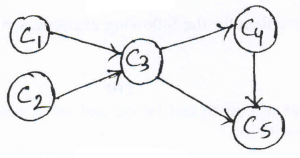DESIGN AND ANALYSIS OF ALGORITHMS
[As per Choice Based Credit System (CBCS) scheme]
(Effective from the academic year 2017 - 2018)
SEMESTER - VI
Subject Code 18CS42
IA Marks 40
Number of Lecture Hours/Week 4
Exam Marks 60
18CS42 - DESIGN AND ANALYSIS OF ALGORITHMS
Important Questions - MODULE - 2
These Questions are being framed for helping the students in the "FINAL Exams" Only (Remember for Internals the Question Paper is set by your respective teachers). Questions may be repeated, just to show students how VTU can frame Questions.
- ADMIN
18CS42 - DESIGN AND ANALYSIS OF ALGORITHMS
Questions Bank - MODULE - 2
1. Design recursive algorithm for binary search and calculate time complexity. (10 Marks) (Dec.2019/Jan.2020 | 17 Scheme)
2. Write an algorithm for merge sort and Trace 60, 50, 25, 10, 35, 25, 73. 30. (10 Marks) (Dec.2019/Jan.2020 | 17 Scheme)
3. Write an algorithm for Quick sort and derive its time complexity. (10 Marks) (Dec.2019/Jan.2020 | 17 Scheme)
4. What is topological sorting? Apply DFS for below graph to solve topological sorting. (10 Marks) (Dec.2019/Jan.2020 | 17 Scheme)

5. Write an algorithm to sort 'n' numbers using Quick sort. Trace the algorithm to sort the following list in ascending order. 80 60 70 40 10 30 50 20 (08 Marks) (June/July 2019 | 17 Scheme)
6. Discuss general divide and conquer technique with control abstraction and recurrence relation. (06 Marks) (June/July 2019 | 17 Scheme)
7. Apply DFS based algorithm and source removal method to find the topological sequence for the graph shown below (06 Marks) (June/July 2019 | 17 Scheme)

8. Apply Strassen's matrix multiplication to multiply following matrices, Discuss how. this method is better than direct matrix multiplication method. (08 Marks) (June/July 2019 | 17 Scheme)

9. Write recursive algorithm to find maximum and minimum element in an array. (06 Marks) (June/July 2019 | 17 Scheme)
10. Write an algorithm to sort 'n' number using merge sort, (06 Marks) (June/July 2019 | 17 Scheme)
11. Discuss how to find maximum and minimum element in an array recursively. Trace the same for the following data set 65, 70, 75, 80, 85, 60, 55, 50, 45. Also derive the worst case complexity. (06 Marks) (June/July 2019 | 15 Scheme)
12. What is stable algorithm? Is quick sort stable, explain with an example. (04 Marks) (June/July 2019 | 15 Scheme)
13. Define decrease and conquer technique and mention all the variations with an example. (06 Marks) (June/July 2019 | 15 Scheme)
14. Design recursive algorithm for merge sort and derive its complexity. (06 Marks) (June/July 2019 | 15 Scheme)
15. How would you demonstrate the steps used in Strassen's matrix multiplication? (04 Marks) (June/July 2019 | 15 Scheme)
16. What actions would to take to perform topological sort using source removal method explain with an example. (06 Marks) (June/July 2019 | 15 Scheme)
17. Discuss how quick-sort works to sort an array and trace for the following data set. Draw the tree of recursive calls made. 65, 70, 75, 80, 85, 60, 55, 5O, 45. Derive the best case complexity of quick sort algorithm. (10 Marks) (Dec.2018/Jan.2019 | 15 Scheme)
18. Briefly explain the Strassen's matrix multiplication. Obtain its time complexity, (06 Marks) (Dec.2018/Jan.2019 | 15 Scheme)
19. Explain the concept of divide and conquer. Design an algorithm for merge sort and derive its time complexity. (10 Marks) (Dec.2018/Jan.2019 | 15 Scheme)
20. What are the three major variations of decrease and conquer technique? Explain with an example for each. (06 Marks) (Dec.2018/Jan.2019 | 15 Scheme)
21. Write a function to find the maximum and minimum elements in a given array of N elements by applying the divide and conquer technique. (06 Marks) (June/July 2018 | 15 Scheme)
22. Explain the divide and conquer technique. Give the general algorithm D And C(P) [Where P is the problem to be solve] to illustrate this technique. (04 Marks) (June/July 2018 | 15 Scheme)
23. Apply source removal method to obtain topological sort for the given graph in Figure (06 Marks) (June/July 2018 | 15 Scheme)

24. Explain the merge sort algorithm. Illustrate with an example and give the worst case efficiency of merge-sort. (08 Marks) (June/July 2018 | 15 Scheme)
25. Apply quick sort algorithm to the following set of numbers. 65, 70, 75, 80, 85, 60, 55, 50, 45. (08 Marks) (June/July 2018 | 15 Scheme)
26. Explain divide and conquer technique. Write a recursive algorithm for finding the maximum and minimum element from a list. (08 Marks) (Dec.2017/Jan.2018 | 15 Scheme)
27. Apply quick sort to sort the list E, X, A, M, P, L, E in alphabetical order. Draw the tree of the recursive calls made. (08 Marks) (Dec.2017/Jan.2018 | 15 Scheme)
28. Discuss Strassen's matrix multiplication and derive its time complexity. (08 Marks) (Dec.2017/Jan.2018 | 15 Scheme)
29. Design merge sort algorithm and discuss its best-case, average-case and worst-case efficiency. (08 Marks) (Dec.2017/Jan.2018 | 15 Scheme)
30. Explain concept of divide and conquer. Write merge sort algorithm. (08 Marks) (June/July 2017 | 15 Scheme)
31. Write a recursive algorithm for binary search and also bring out its efficiency. (08 Marks) (June/July 2017 | 15 Scheme)
32. Illustrate the tracing of quick sort algorithm for the following set of numbers:
25, 10, 72, 18, 40, 11, 64, 58, 32, 9 (08 Marks) (June/July 2017 | 15 Scheme)
33. List out the advantages and disadvantages of divide and conquer method and illustrate the topological sorting for the following graph. (08 Marks) (June/July 2017 | 15 Scheme)

-ADMIN
lIKE THE CONTENT? FOLLOW US ON INSTAGRAM: @futurevisionbie
Get Notified on Instagram Also
ANSWER SCRIP FOR THESE QUESTIONS WILL BE UPLOADED "AS SOON AS POSSIBLE"
Visit: https://hemanthrajhemu.github.io/AnswerScript/
For immediate Notification Join the Telegram Channel
-ADMIN
T = Text book
QB = Question Bank
AS = Amswer Script
-ADMIN

 MENU
MENU

